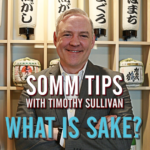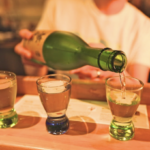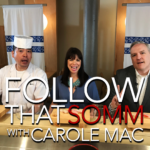
We’ve all been there: blankly staring at the sake list in a Japanese restaurant. How on earth to tell all these different sakes apart? Taking a few minutes to learn the basic ingredients and classifications of sake can go a long way to empower your decisions and help you zero in on the sake just right for you. It doesn’t hurt that your friends will also marvel at your new sake superpowers.
(And if you haven’t read Sake 101: A Guide to the Drink of the Gods, that’s a great place to start. Then pick up here!)
What are the ingredients in sake?
There are four main ingredients in sake: rice, water, yeast and koji mold. Let’s take a look at each one:
Water
80% of a bottle of sake is water, so it has a big impact on the impression of a sake. Depending on the mineral content, water used for making sake can be considered hard or soft. Hard water is generally well water, and the higher mineral content of this type of water makes for a vigorous fermentation that will yield a more robust and rich style of sake. Soft water, on the other hand, is water that is quite low in minerals. This type of water is generally from snow melt, and it makes for a more gentle fermentation that will produce lighter and cleaner styles of sake.
 Yeast
Yeast
Wine, beer and sake all use yeast for their fermentation. Yeast is a microorganism that eats sugar and gives off alcohol, carbon dioxide, and acids. Yeast produces the alcohol and also has a big impact on the aromatics of a sake.
Sake Rice
The most important thing to know about sake rice is that it is different from eating rice. Sake rice is a specialty grain that has a specific structure and is grown only for making sake. The starch of the sake rice grain is concentrated more towards the center in an area known as the shinpaku or ‘white heart,’ while the fats and proteins are more on the outer layers. Eating rice has the fats, proteins and starches more equally distributed throughout the grain.
Koji Mold
Perhaps the most foreign ingredient in sake to those of us outside Japan is Koji mold. Some people are surprised to learn that mold is an integral ingredient in sake, but without this mold, we would not have sake as we know it today. To start, the mold spores are sprinkled onto steamed rice grains and carefully grown on the rice over the course of roughly two days. This mold-covered rice is then added to the sake fermentation mash. The secret is that this mold gives off an enzyme that acts like scissors, breaking down long starch molecules into shorter glucose molecules. In short, Koji mold enzymes convert the starch in the rice grain into fermentable sugars. Yeast then steps in to eat the sugars and create alcohol.
Sake Classifications
More than anything else, I think that understanding the sake classification system will help demystify some of the most important sake vocabulary and assist you when making sake buying decisions at restaurants or wine shops. Sake classifications are broken down by ingredients and rice milling percentages. Both of these factors can impact the taste and texture of a sake and will help us zero in on sakes that suit our palate – and our budget.
At the highest level, all sake will fall into one of two primary categories, based on ingredients. These are called the “Pure Rice” style and the “Alcohol Added” style. The pure rice style is sake made with rice, water, yeast and Koji only, without additives. The “alcohol added” style is sake made with the four pure rice ingredients plus the addition of a limited amount of distilled alcohol. This distilled alcohol’s purpose is to influence the flavor, aroma and texture of the sake, not to make this style more boozy.
Since water is added at the time of bottling, both the pure rice and alcohol added styles generally end up at around 15 % alcohol. Very generally speaking, the pure rice styles of sake will taste more ricey and grainy, with a more crisp and pointed texture. Alcohol added styles of sake generally taste less overtly of rice and have a more round, lighter and silky texture with heighted aromas.
Both of the two primary sake styles have three categories based on the rice milling percentage.
Alcohol Added Styles
Honjozo
This is sake made with the alcohol added ingredients and using rice milled to 70% or less of the grain size remaining. Honjozo is considered the entry to premium for the alcohol added style. Honjozo sakes tend to be round and lighter in texture. Honjozos can still be bold in flavor and are often a good candidate for serving warm. This is also the most affordable of the alcohol added sakes.
Ginjo
This grade uses the alcohol added ingredients and rice milled to 60% or less remaining. Ginjo sake is generally smooth and aromatic. The body can have silky characteristics without being too rich. Ginjo sakes are more expensive than Honjozo.
Daiginjo
This grade of sake reaches a level that is considered Super Premium. This alcohol added style sake requires that the rice be milled to a size of 50% or less remaining. This removes much of the fats and proteins in the grain and creates a true velvety texture that is exceedingly smooth and lucious. Lovely fruity and floral aromas can be pronounced. These sakes are the most expensive of the alcohol added style.
 Pure Rice Styles
Pure Rice Styles
Junmai
The word junmai means “pure rice.” When you see this, you know the sake ingredients: rice, water, yeast and Koji with no additives. Junmai sakes have no minimum rice milling requirement. As long as the ingredient requirements are met, a sake can be sold as a Junmai grade sake. Look for a pronounced rice or grain flavor on the palate. Aromas can hint at steamed rice as well but are generally less intense than the alcohol added styles. Junmai sakes are the most affordable sakes of the Pure Rice style.
Junmai Ginjo
The requirements here are the pure rice ingredients and rice milled to 60% or less remaining. This style of sake is known for being smooth and lightly aromatic. Flavors can be pure and bright. Junmai Ginjo sakes are for the most part more expensive than Junmai Sakes.
Junmai Daiginjo
These are the Super Premium sakes of the pure rice style. They require rice that is milled to 50% or less remaining. Junmai Daiginjo sakes are notable for their silky smooth texture and elegant aromas. These sakes are well crafted and tend to be brewed in small batches to maintain quality. These are the most expensive sakes of the pure rice style.
 With his first sip in 2005, Timothy Sullivan fell in love with premium Japanese sake. This inspired him to start the first sake blog in the United States: UrbanSake.com. Since then, Timothy has received professional sake certifications from The Sake Education Council, The Sake School of America, the Sake Service Institute and the Wine & Spirits Education Trust.
With his first sip in 2005, Timothy Sullivan fell in love with premium Japanese sake. This inspired him to start the first sake blog in the United States: UrbanSake.com. Since then, Timothy has received professional sake certifications from The Sake Education Council, The Sake School of America, the Sake Service Institute and the Wine & Spirits Education Trust.
He has gone on to become a respected educator, teaching the next generation of sake professionals for the Sake School of America, the WSET Sake certification programs as well as in private sake seminars. In October 2016, Timothy was the first person ever to receive a Cultural Activities Visa from the Japanese Government to study the art of sake making at Hakkaisan Sake Brewery in Niigata, Japan.



